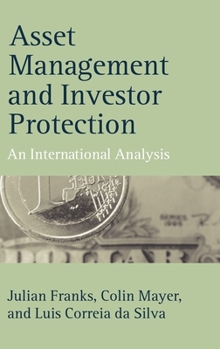Asset Management and Investor Protection: An International Analysis
Select Format
Select Condition 
Book Overview
Asset management is a major industry playing an increasingly important role in economic activity around the world. Traditionally, it has been primarily associated with the 'stock market' economies of the UK and the USA, but as this book shows some of the most spectacular growth in activity of recent years has occurred in continental Europe. This has presented opportunities and challenges. New forms of financial instruments and institutions have emerged in countries that have traditionally relied on debt and non-market forms of intermediation. Competition has intensified and entry has occurred both within and across national markets. However, this growth has been accompanied by potential problems; will investors enjoy a wider range of products and services, they face more complex instruments and transactions. Therefore, the potential for failures, such as misdealing and fraud, may have increased. The natural response is to strengthen regulation, but there is a fine balance to be struck between in adequate and excessive regulation of asset managers. This is particularly complicated in the context of European capital markets. European countries have traditionally had very different financial systems and asset management businesses, therefore it is no surprise to discover that they have many different approaches to regulating asset managers. How should the European Commission respond to this diversity? Should it seek to create greater uniformity via common regulatory rules? The particular focus of this book is financial resource requirements. There is currently an active debate about the role which capital requirements should play in asset management, particularly in the European context. In order to address this issue, the authors argue that it is necessary to understand the nature of the asset management business in different countries and the risks that it faces. They therefore discuss how the asset management business operates; how it is organized; the nature and size of risks in the business, who bears them and ho they are financed; and what the alternative forms of investor protection are, together with their associated costs and benefits.
Format:Hardcover
Language:English
ISBN:0199257094
ISBN13:9780199257096
Release Date:March 2003
Publisher:Oxford University Press, USA
Length:304 Pages
Weight:1.25 lbs.
Dimensions:0.8" x 6.3" x 9.7"
Customer Reviews
1 rating
dry reading
Published by Thriftbooks.com User , 16 years ago
Just a few days ago, Bear Sterns collapsed. An event that the Wall Street Journal said "shook American capitalism". So this book can be of interest to some readers. It does not directly address financial instruments. It deals in a broader context of management. Written in 2003, it describes the regulatory environments in Europe and the United States, for companies that wish to manage financial assets. Very dry reading, though. A considerable portion consists of parsing the different regulations and regulatory bodies that you have to deal with. What prudent means does vary across nations. So too does the capital requirements. There is guidance on how to obtain licenses. Attention is also given to how clients' assets need to be safeguarded, and the responsibilities of the managers.






